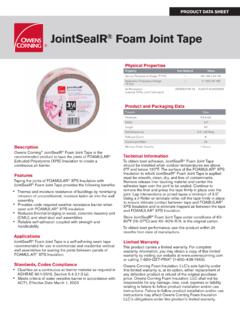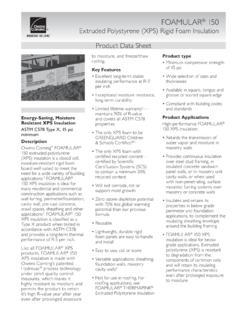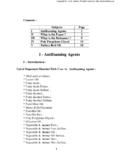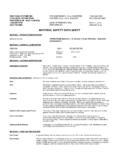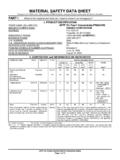Transcription of COLIFOAM 1. Product Name 2. Qualitative and Quantitative ...
1 Page 1 of 9 NEW ZEALAND DATA SHEET COLIFOAM 1. Product Name COLIFOAM , 10% w/w, foam enema. 2. Qualitative and Quantitative Composition One gram of foam enema contains 100 mg of hydrocortisone acetate. Each applicator full of COLIFOAM contains approximately 90 mg hydrocortisone acetate. For the full list of excipients, see section 3. Pharmaceutical Form COLIFOAM is a foam enema supplied in an aerosol can filled with white, odourless, muco-adherent, expanding foam . 4. Clinical Particulars Therapeutic indications Topical treatment of inflammation occurring in the rectal mucosa, ulcerative colitis, proctosigmoiditis and granular proctitis. Dose and method of administration Dose The dosage is one applicator full containing approximately 90 to 100 mg hydrocortisone acetate. The usual dosage rate is one applicator full once or twice daily for two to three weeks, and every second day thereafter, applied as directed into the rectum.
2 Special populations Hepatic impairment A reduction of dosage may be necessary in treating chronic active liver disease with the medicine (see section ). Method of administration Shake aerosol can vigorously for 60 seconds before use. Hold aerosol can upright and insert its nozzle into the tip of the applicator. As a result the applicator will be on top of the aerosol can. Be sure the plunger is drawn all the way out. The aerosol must be held upright to obtain proper flow of medication. To fill the applicator, hold it by the barrel and press down gently on top of aerosol can until the foam has filled up approximately one quarter of the applicators body. Keep the plunger withdrawn during this procedure. Only a short press is needed to do this. Wait for few seconds until the foam has Page 2 of 9 stopped expanding. These steps may be repeated until the foam has reached the fill line. When foam reaches the fill line of the applicator, it is ready for use.
3 Caution: The aerosol can nozzle should never be inserted directly into the anus. Remove applicator from aerosol can. Allow some foam to remain on the applicator tip. Hold applicator by barrel and gently insert tip sufficiently into the anus to ensure the foam is fully deposited into the rectum. With applicator in place, push plunger in order to expel foam , and then withdraw applicator. Some patients find the administration easier when standing with one leg raised or lying down on their side. Applicator parts should be pulled apart for thorough cleaning with warm water. Contraindications Contraindicated in patients with: hypersensitivity to the active substance or to any of the excipients listed in section anal warts fungal, viral, tuberculous or bacterial infections obstruction abscess perforation peritonitis fresh intestinal anastomoses extensive fistulae. Special warnings and precautions for use Treatment should be administered with caution in patients with severe ulcerative disease because of their predisposition to perforation of the bowel wall.
4 Caution should be used in patients with diabetes mellitus, it should be taken into consideration that they may need more insulin or oral anti-diabetics (see section ). Stabilisation to corticoids should be done in a hospital when treating patients with myasthenia gravis. Corticosteroids can cause elevation of blood pressure, salt and water retention in the blood, and increased urinary excretion of potassium. Therefore patients with severe cardiac and/or renal insufficiency will require careful monitoring, and in patients with hypertension, regular blood pressure control is necessary. Potentially severe psychiatric adverse reactions may occur with systemic steroids. Particular care has to be taken in patients with existing or a previous history of severe affective disorders, depressive or manic-depressive illness and previous steroid psychosis. Patients should not be vaccinated with live vaccines while on corticosteroid therapy.
5 Other immunisation procedures should not be undertaken in patients on corticosteroid therapy, especially Page 3 of 9 on high doses, because of possible hazards of neurological complications and lack of antibody response. Immunisation procedures may be undertaken in patients receiving corticosteroids as replacement therapy. Stress and intercurrent illness In patients on long-term corticosteroid therapy subject to stress from trauma or infection, steroid dosage should generally be increased to cover the stressful period. For mild infections without fever no increase is necessary. For more serious infections the dose of glucocorticoid should be doubled normal dose. Infection Corticosteroids may mask some signs of infection ( fever and inflammation), and new infections may appear during their use. There may be decreased resistance and inability to localise infection when corticosteroids are used. Susceptibility to infection is not specific for any particular bacterial or fungal pathogen.
6 Ophthalmological complications Prolonged use of corticosteroids may produce posterior subcapsular cataracts or glaucoma with possible damage to optic nerves, and may enhance the establishment of secondary ocular infections due to fungi or viruses (see section ). COLIFOAM should not be used in patients with narrow- or wide-angle glaucoma. Visual disturbance Visual disturbance may be reported with systemic and topical corticosteroid use. If a patient presents with symptoms such as blurred vision or other visual disturbances, the patient should be considered for referral to an ophthalmologist for evaluation of possible causes which may include cataract, glaucoma or rare diseases such as central serous chorioretinopathy (CSCR) which have been reported after use of systemic and topical corticosteroids. General During prolonged corticosteroid therapy adrenal suppression and atrophy may occur and secretion of corticotrophin may be suppressed.
7 Abrupt withdrawal of corticosteroid therapy may precipitate acute adrenal insufficiency and muscle weakness, hypotension, hypoglycaemia, headache, nausea, vomiting, restlessness and muscle and joint pain. Muscle weakness and stiff joints may persist for three to six months after discontinuation of treatment. In some cases, withdrawal symptoms may stimulate a clinical relapse of the disease for which the patient has been under treatment. Abrupt cessation of therapy should be avoided. Duration of treatment and dosage appear to be important factors in determining suppression of the pituitary adrenal axis response to stress on cessation of steroid treatment. The patient s liability to depression is also variable. Some patients may recover normal function rapidly. In others, the production of hydrocortisone in response to the stress of infections, surgical operations or accidents may be insufficient and death results. Therefore, withdrawal of corticosteroids should always be gradual to avoid a drug induced secondary adrenocortical insufficiency.
8 This type of relative insufficiency may persist for months after discontinuation of therapy, therefore in any situation of stress occurring during that period, hormone therapy should be reinstituted. If the patient is receiving steroids already, dosage may have to be increased. Since mineralocorticoid secretion may be impaired, salt and/or a mineralocorticoid should be administered concurrently. If sudden withdrawal is necessary, corticotrophin (20 units) given daily by intravenous infusion during eight hours for three to five successive days is usually sufficient to prevent withdrawal symptoms. During long courses of treatment, laboratory and metabolic studies should be done. Fluid retention should be watched for, via a fluid balance chart and daily weighing. Sodium intake may need to be reduced to less than 1 g daily and potassium supplements may be necessary. The possibility of development of osteoporosis should be an important consideration in initiating and managing corticosteroid therapy, especially in postmenopausal women (see section ).
9 Close observation is necessary in patients with latent Page 4 of 9 tuberculosis or tuberculin reactivity as reactivation of the disease may occur. Chemoprophylaxis is indicated during prolonged corticosteroid therapy. Special Populations Impaired hepatic function Use with caution in patients with impaired hepatic function. A reduction of dosage may be necessary in treating chronic active liver disease with the medicine. Major adverse reactions such as vertebral collapse, diabetes, hypertension, cataracts and Cushing s syndrome occur in about 30% of patients. Paediatric population Children on long-term steroids must be carefully observed for potential serious reactions such as obesity, growth retardation, osteoporosis and adrenal suppression. Use in the elderly Caution is recommended for elderly patients, as they are more susceptible to adverse reactions. Laboratory tests Corticosteroids may affect the nitroblue tetrazolium test for bacterial infection and produce false negative results.
10 False negative results in the dexamethasone suppression test in patients being treated with indomethacin have been reported. Glucocorticoids can lead to positive results in doping tests. Interaction with other medicines and other forms of interaction The active substance hydrocortisone is absorbed up to 5% in the gastrointestinal tract. For systemic hydrocortisone, interactions with the following medicines are known: The effects of cardiac glycosides may be potentiated, caused by potassium depletion. When corticosteroids are administered concomitantly with potassium depleting agents such as diuretic agents and amphotericin B, patients should be observed closely for development of hypokalaemia. Macrolide antibiotics and ketoconazole may decrease corticosteroid clearance. Anti-diabetics may have a reduced effect on lowering blood sugar. Salicylates and other NSAIDs which may increase the risk of gastrointestinal bleeding. Antiretroviral agents due to the risk of adrenal suppression.











